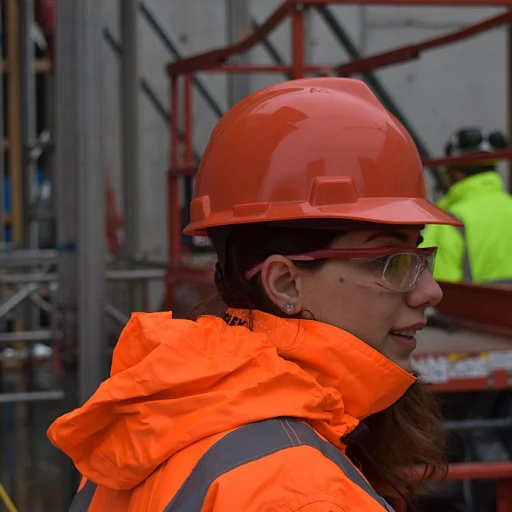
Understanding Human Resources Analytics
Decoding Human Resources Analytics for the Workplace
Human resources analytics has proven to be a game-changer in creating a more intelligent work environment. As organizations shift towards a more data-driven approach, the reliance on data analytics becomes crucial to boosting workplace efficiency and experience. HR analytics empowers management to delve into vast amounts of employee data to make informed decisions that enhance the overall work environment. To create a smarter workplace, HR analytics combines various technology tools to collect, analyze, and interpret data from different office settings. This includes examining employee experience, space utilization, and time data, which help in crafting a hybrid workplace approach that accommodates the evolving nature of work. Companies are leveraging workplace technology through real-time data to transition to a smart work office. This shift has been augmented by digital signage for clearer communication within the office, ultimately leading to more effective space management and meeting room allocations. Indeed, understanding and applying human resources analytics can significantly transform your organization into a simply smarter workplace. For more insights into how HR technology can shape the future of workplace strategies, you can explore the advancements in HR technology. This knowledge is a stepping stone to crafting efficient, employee-centered workplaces that meet the dynamic demands of the modern work environment.The Role of Data in Enhancing Workplace Intelligence
Data as the Foundation of Workplace Intelligence
The modern work environment has evolved significantly with the integration of data analytics, transforming into a smarter and more adaptable space. This shift is evident in the transition from traditional office setups to hybrid workplaces and smart offices. The ability to leverage data in real time is central to these advancements, enabling organizations to create a work environment that not only meets but anticipates the needs of its employees. Data-driven strategies in a workplace involve utilizing various workplace technologies and tools to collect and analyze data related to employee experience, space utilization, and workplace strategy. These insights can lead to more efficient space management, allowing companies to optimize their real estate investments and create an environment that supports the hybrid work model. For instance, understanding space utilization through digital signage and smart offices can help in planning better meeting rooms and workspaces. Furthermore, by applying data analytics, companies can effectively manage employee time data, enhancing both productivity and job satisfaction. In a hybrid work setup, leveraging data ensures that the transition between in-office and remote work is seamless, enhancing overall workplace experience. To dive deeper into how data can navigate the complexities of a smarter and hybrid work environment, you can explore the comprehensive insights shared here. This resource offers a broader perspective on how data analytics is shaping modern workplace strategies, ensuring that companies are equipped with the tools they need to succeed in a digital-first world.Key Metrics to Track for a Smarter Workplace
Crucial Metrics for Fostering a Smart Work Environment
In a bid to make the workplace smarter, understanding and tracking the right metrics is paramount. Human resources analytics offers a suite of tools that allow organizations to monitor and enhance their work environments in real time. By leveraging data analytics, companies can gain insights into crucial aspects of their operations, from space utilization to employee productivity.
Below are some key metrics that organizations should focus on to optimize their workplace strategy:
- Space Utilization: This involves understanding how much of the office space is being used and can help in improving real estate decisions. By analyzing these data, companies can tailor their office layouts to suit the needs of a hybrid workplace or a smart office, thus ensuring a simply smarter use of available resources.
- Employee Experience: Gathering feedback on workplace technology and the overall work environment can enhance the employee experience. Monitoring these metrics helps in identifying the need for digital solutions such as digital signage for a seamless workplace experience.
- Time Management and Productivity: Tracking time data is essential to understanding how employees are investing their time throughout the day. This can provide insights into potential areas for improvement, assisting in creating a smarter workplace that supports employees' productivity.
- Meeting Room Utilization: Monitoring the usage of meeting rooms through workplace technology can help improve booking systems and reduce wastage of resources. This metric is vital for a hybrid work environment where space management is key.
By focusing on these data-driven metrics, organizations can develop better management strategies and foster a more intelligent workplace environment. This not only enhances the employee experience but also maximizes efficiency and productivity across the board.
Leveraging Predictive Analytics for Workforce Planning
Leveraging Predictive Insights for Workforce Success
Predictive analytics has emerged as a cornerstone in shaping a smarter workplace environment. By using advanced data analytics tools, organizations can navigate the complexities of both real time and future workforce needs effectively. This not only leads to better space management but also enhances the overall employee experience. Predictive analytics in human resources focuses on using historical data to forecast future trends and needs. This powerful approach allows management teams to make informed decisions, leading to an optimized work environment and better outcomes for employees.- Space Utilization: Real estate and space utilization become more efficient by analyzing trends in office occupancy and meeting room bookings. A smart office environment ensures that spaces are used effectively, catering to both traditional and hybrid workplace models.
- Employee Retention: By identifying patterns related to employee turnover, organizations can implement targeted strategies to retain talent. This proactive approach minimizes disruptions and maintains a stable work environment.
- Workforce Planning: Predictive analytics assists in understanding hiring needs and future skill requirements. Anticipating these needs ensures that the workplace is equipped with the right talent at the right time.
Challenges in Implementing HR Analytics
Overcoming Challenges in Implementing HR Analytics
While the promise of human resources analytics in cultivating a smarter workplace is vast, the path to implementation is fraught with challenges. Adopting data-driven strategies to enhance the work environment must be approached with careful planning and consideration to ensure success.
Firstly, the integration of new technologies and tools into the existing office infrastructure often poses difficulties. Many organizations must navigate complexities related to technology compatibility and the seamless incorporation of digital solutions into their operations. This process requires a thorough assessment of current resources and potential gaps to ensure the smart workplace solutions are effectively utilized.
Data quality is another critical consideration. For analytics to provide real insights, the data must be accurate, complete, and collected in real time. Companies must establish robust data management practices to maintain the integrity and reliability of their data. Regular audits and validations are vital to prevent discrepancies that could undermine analytics efforts.
Furthermore, transforming raw data into actionable insights demands expertise in data analytics. Many organizations face a skills gap when it comes to interpreting complex data sets and extracting valuable insights. Investing in training or hiring skilled analysts becomes necessary to overcome this barrier and truly capitalize on available data.
Employee buy-in is also essential for the successful implementation of HR analytics. Employees may resist changes in their work environment, especially when new technologies are involved. It's crucial for management to effectively communicate the benefits of these changes and involve employees in the transition process to foster acceptance and adaptation.
Finally, challenges related to data privacy and security cannot be overlooked. The handling of sensitive employee information requires stringent safeguards to prevent unauthorized access and breaches. Developing and enforcing comprehensive data protection policies helps reassure employees and complies with regulatory standards.
Despite these obstacles, organizations that strategically address these challenges stand to gain substantial benefits from HR analytics. By enhancing the employee experience and optimizing space utilization, organizations can create a more intelligent, efficient, and responsive workplace tailored to both individual and organizational needs.












